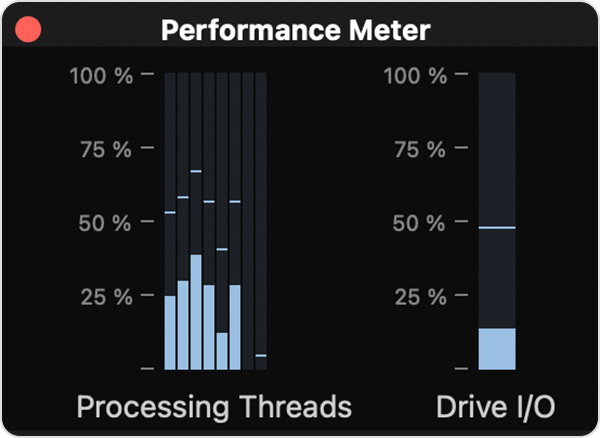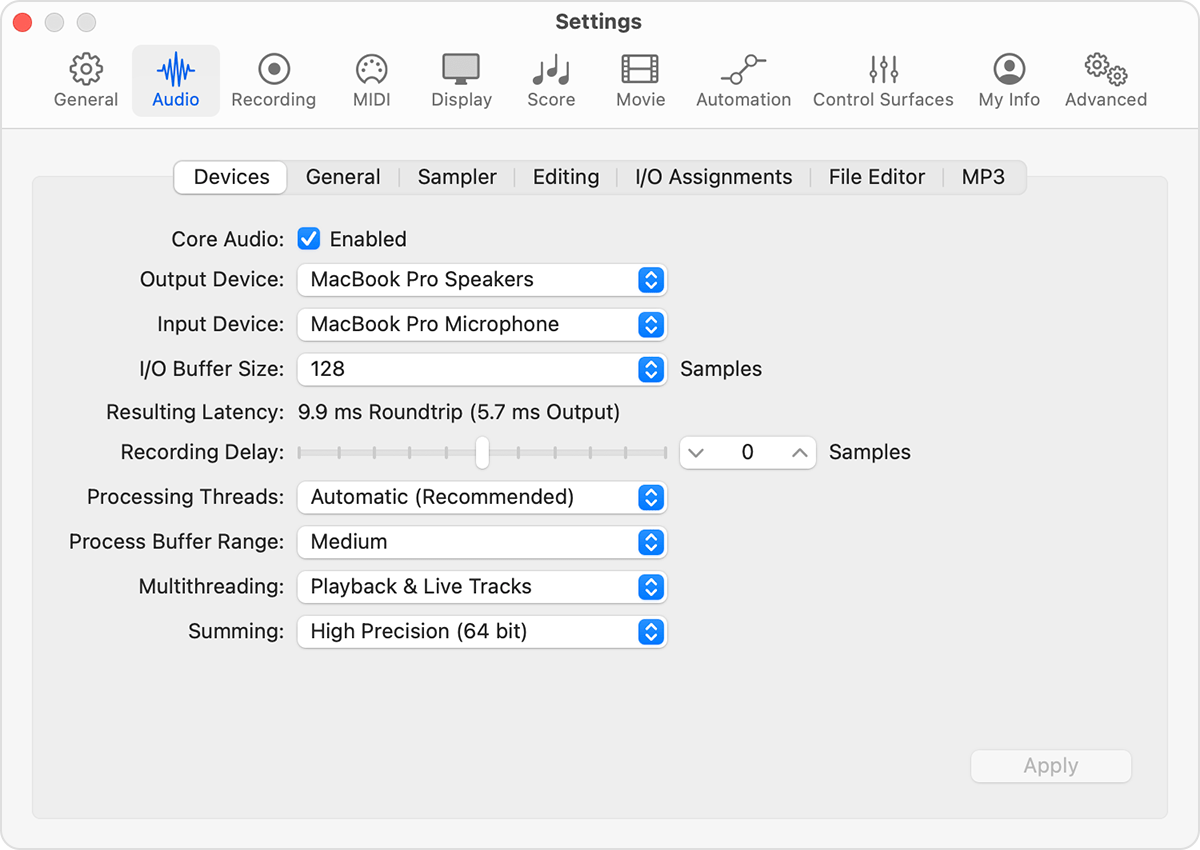Avoid system overloads in Logic Pro for Mac
Learn what to do if a system overload alert interrupts playback or recording in Logic Pro.
If your Logic Pro project has a lot of audio tracks, software instruments, or plug-ins, you might get a system overload alert that interrupts playback or recording. System overloads can occur when your Mac doesn't have enough processing power to play back or record audio. Use the techniques in this article to avoid system overloads.
Configure your system
Follow these guidelines when configuring your system for use with Logic Pro:
Quit other apps when using Logic Pro, except for the control or mixer software used by your audio interface.
Make sure your Mac has enough RAM, especially if your projects usually include many plug-ins or multiple instances of the Sampler.
Save projects with high track counts to a dedicated storage device such as an external USB-C solid-state drive (SSD) instead of saving projects to the system drive of your Mac.
If your projects include multiple instances of the Sampler, use a dedicated hard drive to store samples. Always use a dedicated drive if you use the Virtual Memory option with the Sampler.
Format hard disks, flash drives, or other storage devices used with Logic Pro in the APFS or Mac OS Extended (Journaled) format.
Monitor system performance
Use the meters in the Logic Pro Performance Meter to monitor system performance while working on a project. To view the Performance Meter:
Choose Logic Pro > Settings (or Preferences) > Advanced Tools, then select Show Advanced Tools. Choose any other additional options to streamline your workflow.
Choose View > Customize Control Bar and Display.
Choose Custom from the pop-up menu in the LCD section.
Select Performance Meter (CPU/HD), then click OK.
The Performance Meter appears on the right side of the LCD. Double-click the CPU meter to open it in a new, expanded window.

The Performance Meter has two sets of meters:
Processing Threads: Shows the amount of CPU and RAM processing power Logic Pro is using on the available cores in your Mac. Each core in your Mac has its own meter. On Intel-based Mac computers with processors that support Hyper-Threading, two meters are shown for each core.
Drive I/O: Shows the amount of disk bandwidth used by Logic Pro.
Watch the meters as the project plays back, noting when the meters are full. When a meter is full, the CPU or the disk has reached the limit of its processing capability. System overload alerts can appear when any of these meters peak. You can use this information to make adjustments to your project or your system configuration.
Set audio device options
Choose Logic Pro > Settings (or Preferences) > Audio, click Devices, then adjust the following settings:
I/O Buffer Size: Increase the I/O buffer size, up to a maximum of 256 samples. The I/O buffers temporarily store audio data before sending it to other destinations on your Mac. Increasing the I/O buffer size reduces the load on the CPU of your Mac. However, larger I/O buffer sizes increase latency when recording.
To avoid latency and system overload alerts, decrease the I/O buffer size when recording, then increase it when mixing. If you're recording audio and not software instruments, you can monitor your audio directly from the source. Choose Logic Pro > Settings (or Preferences) > Audio > General, and deselect Software Monitoring. You can then set the I/O buffer size to 256 samples and leave it there for both recording and mixing.
Process Buffer Range: Set this option to Large. As with the I/O buffers, higher settings increase latency.
Multithreading: Multithreading affects how Logic distributes the DSP resources of your Mac. Learn more about how to use the Multithreading setting to optimize performance.
ReWire Behavior: If you aren't using ReWire, then set this option to Off. If you are using ReWire, set this option to Playback Mode. This option is only available in Logic Pro on Intel-based Mac computers.

Set automation options
If your project doesn't include automation, or the automation doesn't need to be sample accurate, you can reduce the CPU load by turning off Sample Accurate Automation.
Choose Logic Pro > Settings (or Preferences) > Audio, then click General.
From the Sample Accurate Automation pop-up menu, choose Off.
If your project does include automation, choose the option that includes only the parameters you're automating.
Choose the best sample rate for your project
Projects with higher sample rates create larger audio files, which can increase the load on the CPU and disk. Plug-ins also require more CPU power to process audio files at higher sample rates. When choosing the sample rate for your project, balance the considerations of audio quality, the anticipated format of the final product, and the performance of your Mac. If disk activity is causing system overload alerts, try choosing lower sample rates for your projects.
Use send effects
When using CPU-intensive effect plug-ins such as reverbs and delays, you can reduce the load on the CPU by using send effects. Send effects let you use a single plug-in to process signals from multiple channels.
Avoid inserting effect plug-ins on individual tracks in a project. If you need to insert reverb plug-ins on individual tracks, try less CPU-intensive reverbs like the SilverVerb and PlatinumVerb.
Optimize software instruments
Use these guidelines when working with software instruments:
When mixing, make sure to select an Audio track or an External MIDI track, not a Software Instrument track. Select a Software Instrument track only when you're actively working on it. If your project includes Track Stacks, make sure no Software Instrument sub-tracks are selected.
Freeze tracks, especially tracks with a lot of plug-ins. However, if system overload alerts coincide with peaks in the Drive I/O meter, avoid freezing Software Instrument tracks. Freezing Software Instrument tracks can increase the load on the disk, increasing the likelihood of encountering a system overload alert.
Set the number of voices used in a software instrument to the lowest number required. For example, if you have a Sculpture track that plays only two simultaneous notes, you could set that instance of Sculpture to use two voices.
Optimize Sampler Virtual Memory settings
You can adjust Virtual Memory settings for the Sampler to optimize its performance:
Choose Logic Pro > Settings, then select Audio.
Click Sampler, then click the Virtual Memory tab.
Adjust the following settings:
Active: If most of your system overload alerts coincide with peaks in the Processing Threads meters, select this option. If the alerts coincide with peaks in the Drive I/O meter, deselect it. When you turn on Sampler virtual memory, only the initial attacks of audio samples are loaded into the computer RAM; the rest of the sample is streamed in real-time from the hard drive.
Buffer Range pop-up menu: This setting determines the size of the buffer used for processing audio samples. You can choose between Small, Medium, and Large buffer sizes.
Host Disk Activity pop-up menu: If your projects include very few audio tracks, select Less. If your projects include a lot of audio tracks, select Average or Extensive.
Virtual Memory settings are global—they affect all instances of the Sampler in all projects.
Optimize Alchemy
You can also optimize Alchemy for improved performance.